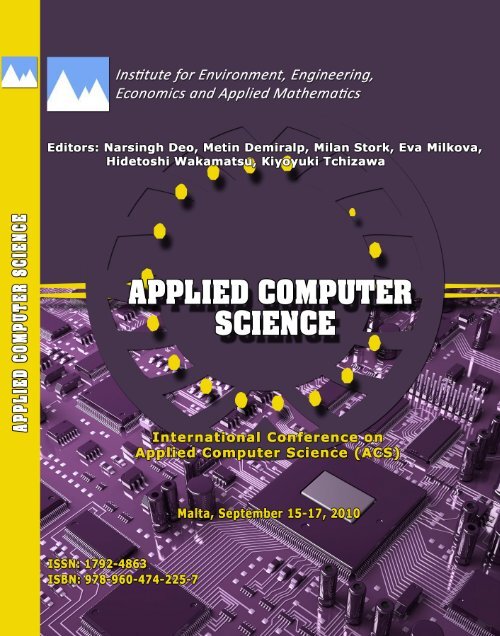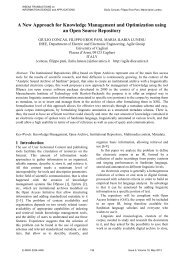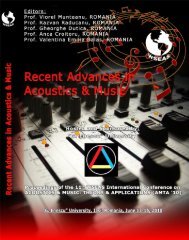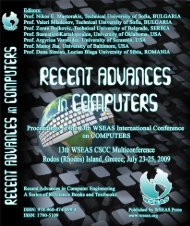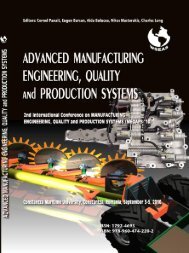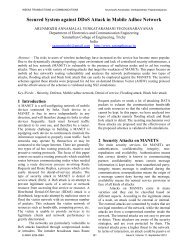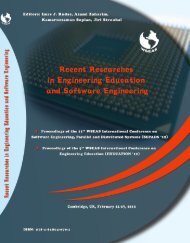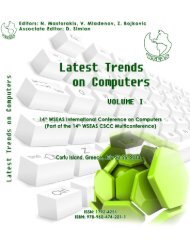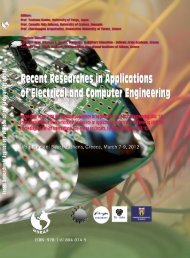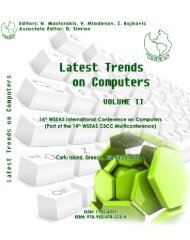Applied Computer Science - Wseas.us
Applied Computer Science - Wseas.us
Applied Computer Science - Wseas.us
- No tags were found...
You also want an ePaper? Increase the reach of your titles
YUMPU automatically turns print PDFs into web optimized ePapers that Google loves.
APPLIED COMPUTER SCIENCEInternational Conference on <strong>Applied</strong> <strong>Computer</strong> <strong>Science</strong> (ACS)MaltaSeptember 15-17, 2010Published by WSEAS Presswww.wseas.orgISSN: 1792-4863ISBN: 978-960-474-225-7
APPLIED COMPUTER SCIENCEInternational Conference on <strong>Applied</strong> <strong>Computer</strong> <strong>Science</strong> (ACS)Malta, September 15-17, 2010Published by WSEAS Presswww.wseas.orgCopyright © 2010, by WSEAS PressAll the copyright of the present book belongs to the World Scientific and Engineering Academy andSociety Press. All rights reserved. No part of this publication may be reproduced, stored in a retrievalsystem, or transmitted in any form or by any means, electronic, mechanical, photocopying, recording, orotherwise, without the prior written permission of the Editor of World Scientific and Engineering Academyand Society Press.All papers of the present volume were peer reviewed by two independent reviewers. Acceptance wasgranted when both reviewers' recommendations were positive.See also: http://www.worldses.org/review/index.htmlISSN: 1792-4863ISBN: 978-960-474-225-7Institute for Environment, Engineering, Economics and <strong>Applied</strong> Mathematics
Editors:Narsingh DeoMetin DemiralpMilan StorkEva MilkovaHidetoshi WakamatsuKiyoyuki TchizawaInternational Program Committee Members:Nikos Mastorakis, BULGARIARonald Yager, USAAmauri Caballero, USAGeorge Vachtsevanos, USARobert Finkel, USADemetrios Kazakos, USATheodore Trafalis, USATakis Kasparis, USAZhiqiang Gao, USAYan Wu, USASpyros Tragoudas, USAArkady Kholodenko, USAGregory Baker, USAGaligekere Dattatreya, USACaroline Sweezy, USAAsad Salem, USADian Zhou, USAMetin Demiralp, TURKEYOlga Martin, ROMANIAPanos Pardalos, USAConstantin Udriste, ROMANIAKleanthis Psarris, USAAndrew D. Jones, USAValeri Mladenov, BULGARIANeri F., ITALYChen S. Y., P. R. CHINAShyi-Ming Chen, R.O.C.Yen K., USARong-Jyue Fang, TAIWANArgyrios Varonides, USANikolai Kobasko, USAXu Anping, P. R. CHINAZhu H., JAPAN
Proceedings of the International Conference on <strong>Applied</strong> <strong>Computer</strong> <strong>Science</strong>Table of ContentsKeynote Lecture 1: Finding Communities in Web-like Complex Networks 15Narsingh DeoKeynote Lecture 2: New Generation HDMR Based Multiway Array Decomposers: EnhancedMultivariance Products Representation (EMPR)Metin Demiralp16Plenary Lecture 1: State Space Energy Approach And Nonlinearly Coupled Systems 17Milan StorkPlenary Lecture 2: Breadth First Search Tree and x-y Shortest Paths Tree 18Eva MilkovaPlenary Lecture 3: Aerobic Bioprocess: Modelling and Control 19Mihai CaramihaiPlenary Lecture 4: Computational Study of Molecular Mechanisms of Caffeine Actions 20Valery PoltevPlenary Lecture 5: Knowledge management strategy for Small and Medium Enterprises 22Elissaveta GourovaPlenary Lecture 6: Political machinery: sophisticated software to assist governance 23Saurabh KwatraPlenary Lecture 7: <strong>Computer</strong> Aided Evaluation of Heat Exchangers 25Gheorghe BacanuPlenary Lecture 8: The Overview of SC Macrodiversity System Second Order StatisticsOperating over Shadowed Fading ChannelsDragana KrsticPlenary Lecture 9: Better living arrangement supported by communication technique from theviewpoints of beneficiariesHidetoshi Wakamatsu2627Plenary Lecture 10: Intelligent online learning systems 28Dalia BaziukaitePlenary Lecture 11: 4-dim duck solution in a trading economic model 29Kiyoyuki TchizawaPlenary Lecture 12: Parametric control in continua based on the new numerical approach 30Ivan KazachkovPlenary Lecture 13: Admission-Discharge-Transfer Gateway Interface: A Health Level 7Application for Hospital Information SystemsCoskun Atay317
Proceedings of the International Conference on <strong>Applied</strong> <strong>Computer</strong> <strong>Science</strong>Plenary Lecture 14: Periodic And Aperiodic Dynamics From A Resistively CoupledNonidentical Superconducting Junction Under Dc ExcitationsErol Kurt32Plenary Lecture 15: The Role of Environmental Indicators in Environmental Management 33Davorin KraljPlenary Lecture 16: Managerial Methods to Control the Downside Risk of Derivatives 34Patrick L. LeoniAdmission-Discharge-Transfer Gateway Interface: A Health Level 7 Application 35Mehmet S. Unluturk, Coskun AtayReal Time Transaction Server 44Mehmet S. Unluturk, Coskun AtayComputational Study of Molecular Mechanisms of Caffeine Actions 51V. I. Poltev, E. Rodriguez, T. I. Grokhlina, A. V. Teplukhin, A. Deriabina, E. GonzalezIris Recognition <strong>us</strong>ing Corner Detection 56Pranith Abbaraju, B. SrikarUsing Distributed Database Technology to Simplify the ETL Component of Data Wareho<strong>us</strong>e 61Abid Ahmad, Muhammad ZubairRead Access to Relational Databases in a CORBA-based Architecture 66Arne Koschel, Irina AstrovaThe Compensation of the Thermocouples Cold Junction Temperature Variation Errors <strong>us</strong>ing aNeuro-Fuzzy ControllerTeodor Lucian Grigorie, Mihai Lungu, Petre Negrea, Dalia Baziukaite72Adaptive B<strong>us</strong>iness Device Integration Architecture: Event Manager 78Mehmet S. Unluturk, Kaan KurtelAn Extension to Existing Nurse Call Systems: Event Manager Server 83Mehmet S. Unluturk, Kaan KurtelAbout Modeling of the Corium Jet Penetrating the Pool of Volatile Coolant under ReactorVesselVahid Hasani Moghaddam, Ivan V. KazachkovPerformance Evaluation of Close-ended Mutual Funds by Investment Objectives in Pakistan'sEconomyShazia Iqbal Khalid, Zaheer Abbas, S. M. Amir Shah8996Concept Hierarchy_based Cube Aggregation for ETL Process in Matriculation Wareho<strong>us</strong>e 108Zar Ni Mg8
Proceedings of the International Conference on <strong>Applied</strong> <strong>Computer</strong> <strong>Science</strong>A New Heuristic Classifier Design Based on Independent Component Analysis and WaveletMethodsCorina Sararu, Luminita State, Maria MiroiuLearn from Practice: Defining an Alternative Model for Software Engineering Education inMexican Universities for Reducing the breach between Ind<strong>us</strong>try and AcademiaI. Garcia, C. Pacheco, N. Coronel114120Vein and Fingerprint Identification Multi Biometric System: A Novel Approach 125Hatim A. AboalsamhUnified Application of Tele-healthcare Architecture and Globalized Patient IDs 130Adnan Ashraf, Ghulam M<strong>us</strong>tafa, B. S. Chowdhry, M. A. HashmaniAgile Adoption – Crossing the Chasm 139Amitoj Singh, Kawaljeet SinghSuggestion of Proper Boundary Conditions to Solving Schrodinger Equation for DifferentPotentials by Runge-Kutta MethodH. Arabshahi, M. Rezaee Rokn Abadi145Use of Simulation in the Public Sector 149Andrej Kovacic, Bojan PecekCase Study Tools in the Multimedia Interactive Teaching-Learning Platform for EnergyTechnologyRoman Tomyak, Ivan V. Kazachkov, Torsten H. FranssonExperiences of Implementing a Software-Subcontracting Management Model in Small-SizeEnterprisesI. Garcia, C. PachecoModeling and Simulation of the High-Temperature Jet's Penetration Behaviours in a Pool ofVolatile CoolantSergei V. Begun, Ivan V. KazachkovPeculiarities of the Local Abnormal Heat Transfer due to Non-Linear Heat Conductivity andtheir Influence on the Steam (Gas) Non-Isothermal Filtration through the Particles LayerSergei V. Begun, Ivan V. Kazachkov156163173179About Some Properties of Some Elementary Epidemic Models 185M. De la Sen, S. Alonso-QuesadaThe <strong>Computer</strong> - Aided Investigation of the Humid Air Processes 192Virgil B. Ungureanu, Daniela Sova, Wilhelm Laurenzi, Gheorghe BacanuWays of Modeling of Mobile Processes 198Tomas Kozel, Filip Maly, Antonin SlabyReversible Discrete Event Controllers for Flexible Manufacturing Systems 202C. Ciufudean, C. FiloteBoundary Labeling with Octilinear Leaders and Minimum Number of Leader-Bends? 208Michael A. Bekos, Antonios Symvonis9
Proceedings of the International Conference on <strong>Applied</strong> <strong>Computer</strong> <strong>Science</strong>Using Petri Net Classes for System Requirements Engineering 214A. Spiteri StainesCreating an Oscilloscope Driver 220Roland Szabo, Aurel Gontean, Ioan Lie, Mircea BabaitaExtended Fluctuationlessness Theorem and its Application to Numerical Integration 226Cosar Gozukirmizi, Metin DemiralpHeuristic Evaluation of Usability of Public Administration Portal 234Miloslav Hub, Vera CapkovaFluctuation Free Matrix Representation Based HDMR Method to Model Multivariate Data 240M. Alper Tunga, Metin DemiralpAn Iterative Enhanced Multivariance Product Representation Scheme for MultivariateFunction DecompositionBurcu Tunga, Metin Demiralp247Information System of Railway Undertakings' Train Track Requirements 254Karel Greiner, Josef VolekLearning Styles <strong>Applied</strong> in the Process of e-Learning 259I. Simonova, M. Bilek, J. Lasek, P. KrizICT and Audiovisual Technic in Nurseries in the Czech Republic 265Martina Manenova, Martin SkutilComposite Materials Properties Approached by Finite Element Method 269Diana L. Cotoros, Anca E. Stanciu, Mihaela I. BaritzHome Emergency Call as a Prevention of Maltreatment of Seniors 273M. Zumarova, B. BalogovaInternet Social Networks in the Contemporary Adolescents Lives 279L. Stasova, G. Slaninova, M. ZumarovaHigher Education Management Dashboards 285M. Muntean, Gh. Sabau, A. R. Bologa, A. FloreaA Mean-Variance Approach to Fisheries Management 291Mari<strong>us</strong> Radulescu, Constanta Zoie Radulescu, Magdalena Turek RahoveanuApplicability of Six Sigma Methodology for Services Output Evaluation 297Stanislava Simonova, Hana SkopeckovaA Hybrid Multi-Criteria Method for Performance Evaluation of Romanian South MunteniaRegion in Context of S<strong>us</strong>tainable AgricultureConstanta Zoie Radulescu, Adrian Turek Rahoveanu, Mari<strong>us</strong> Radulescu303Comparative Study of the Moodle and WebCT Management Systems 309Martina Manenova, Vera TauchmanovaYoung Generation and their Internet Communication 313Monika Zumarova, Miloslava Cerna, Vaclav Manena10
Proceedings of the International Conference on <strong>Applied</strong> <strong>Computer</strong> <strong>Science</strong>Extended Fluctuationlessness Theorem and its Application to Numerical Approximation viaTaylor SeriesN. A. Baykara, Ercan Gurvit, Metin Demiralp317Evaluation of Breast Cancer Risk by Using Fuzzy Logic 324M. Caramihai, I. Severin, A. Blidaru, H. Balan, C. SaptefratiFuzzy Application in Bioprocess Control. A Case Study 330Mihai Caramihai, Cristina Tanase, Camelia Ungureanu, Gheorghe Sarbu, Ana Aurelia Chirvase,Adrian OnuAffine Transformational Enhanced Multivariance Product Representation (ATEMPR) and itsRelation to Rational ApproximantsBerfin Kalay, Metin Demiralp336E-Learning 2.0: Using Mashups in University Courses – a Croatian Experience 341Nikola Vlahovic, Zeljka Pozgaj, Vesna Bosilj VuksicCombined Small Scale Enhanced Multivariance Product Representation 350Evrim Korkmaz Ozay, Metin DemiralpThe Use of a Software Application Supporting Individual Learning Styles in eLearning 357Petra Poulova, Ivana Simonova, Pavel JaneckaExtended Fluctuationlessness Theorem and its Application to Numerical Integration via TaylorSeriesErcan Gurvit, N. A. Baykara, Metin DemiralpAutomatic Detection of Bottleneck Processes through Perturbation-based Reperc<strong>us</strong>sionAnalysisYuya Kosaka, Daisuke Kinoshita, Hiroki Uchikawa, Seiichi Komiya362369Determining Geometrical Parameters at Laser Shutter 375G. Kulvietis, I. Tumasoniene, R. Bansevici<strong>us</strong>, A. Grigoravici<strong>us</strong>, V. Jurenas, S. NavickaiteModels and Patterns for Achieving Semantic Interoperability 380Gheorghe Sabau, Alexandra Florea, Mihaela Muntean, Razvan Bologa, Roxana IrimiaInformational Inefficiency of Forex Markets and the Technical Analysis Rules as a Premise ofAutomatic Trade: The USD / CAD CaseB. Dima, I. Talpos, M. G. Pirtea385BFS Tree and x-y Shortest Paths Tree 391Eva MilkovaThe Modified Renyi-ClipX Conceptual Cl<strong>us</strong>tering Algorithm 396Dalia Baziukaite, Aleksas Narsci<strong>us</strong>Multi-Criteria Adaptation Mechanism of Agent Environment Behavior in AmbientIntelligence ServicesPetr Tucnik, Peter MikuleckyQuantum Evolutionary Algorithm <strong>Applied</strong> to Time Independent Transient Identification of aNuclear Power PlantAndressa dos Santos Nicolau, Roberto Schirru40140611
Proceedings of the International Conference on <strong>Applied</strong> <strong>Computer</strong> <strong>Science</strong>Web-Application User Identification 414Oldrich HorakProblems in Usability of Web-Based GIS 419Jitka Komarkova, Pavel Sedlak, Martin Novak, Veronika Slavikova, Alena M<strong>us</strong>ilovaModelling of Spatial Analyses Processes for Purpose of Detection of Weak Points in Barrier-Free EnvironmentPavel Sedlak, Jitka Komarkova, Martin Jedlicka, Radek Hlasny, Ivana Cernovska426<strong>Computer</strong> Simulation of Stock Exchange Behavior in Maple System 432Zuzana Chvatalova, Jiri Hrebicek, Martin ZigardyMobility Support in Integrated EPON-WiMAX Network Access Architecture 437Ying Yan, Lars DittmannData Envelopment Analysis for the Efficiency Analysis in a Cross-University Comparison 441Marilena Aura Din, Georgiana Camelia CretanReductive Multilinear Array Decomposition Based Support Functions in EnhancedMultivariance Product Representation (EMPR)Emre Demiralp, Metin Demiralp448Nonlinear Multi Regression Model for High Performance Liquid Chromatography 455Stanislava LabatovaSecure Communication based on Digital Chaotic System Using Dual Receiver 459M. StorkLearners/Experience in LMS in 2001 – 2010: Case Study 464I. SimonovaDynamic TV-Content Augmentation by Web Pages 469Massimo Deriu, Alessandro Soro, Gavino PaddeuDigital Library of University of Maribor (More than J<strong>us</strong>t a Bunch of Documents) 473Janez Brezovnik, Milan OjstersekA Comparison of Attribute and Tuple Time Stamped Bitemporal Relational Data Models 479Canan Eren AtayNumerical Analysis of an Active FBG Sensor 490Sorin Miclos, Dan Savastru, Ion LancranjanTheoretical Analysis of an Active FBG Sensor Output Noise 498Dan Savastru, Sorin Miclos, Ion Lancranjan<strong>Applied</strong> <strong>Computer</strong> <strong>Science</strong> to Establish Active Correlation for Improving the Handling Skills 504Cotoros Diana, Baritz Mihaela, Serban IonelAdvanced Manufacturing Technology: Anticipated and Realized Benefits 508Lib<strong>us</strong>e Svobodova, Josef Hynek, Vaclav Janecek12
Proceedings of the International Conference on <strong>Applied</strong> <strong>Computer</strong> <strong>Science</strong>Analysis of Beam Failure Based on Reliability System Theory Using Monte Carlo SimulationMethodMohammad Masoud Azhdari Moghaddam516A Tool for the Tag Management for the Building of Smart Environments 520Pilar Castro Garrido, Guillermo Matas Miraz, Irene Luque Ruiz, Miguel Angel Gomez-NietoParallel Metaheuristics for Resource Scheduling of Virtualized Multicore Plarforms 525Plamenka Borovska, Ognian Nakov, Georgi YanchevA Target Environment Programming Language to Improve Developer's Productivity – A CaseStudyJose Metrolho, Monica Costa, Fernando Reinaldo Ribeiro, Eurico Lopes530Intelligent Information Retrieval within Digital Library <strong>us</strong>ing Domain Ontology 534Thinn Mya Mya SweIntelligent Sensor Web Management Using Multi-Agent Geo-Simulation Techniques 540Mehdi MekniQuality of Web-Based Intranet GIS Application 549Jitka Komarkova, Miloslav Hub, Jana Neumannova, Ondrej VisekTwo Degrees-of-Freedom Controller Design for Electrical Cart System based on Inverse FuzzyModelIgor Skrjanc555Face Recognition in Video Based on One Frontal View 558Marijan ZivicGEMIS and QUADRO – Two Projects to Improve Didactics in <strong>Computer</strong> <strong>Science</strong> 563R. Pucher, M. Tesar, T. Mandl, G. Holweg, F. SchmollebeckFault Tolerance Mobile Agent System Using Witness Agent in Mesh Networks 569Ahmad Rostami, Hassan RashidiWeb 2.0 and its Impact on Information Extraction Practices 574Nikola VlahovicEvaluation of BBS-based Information Management System in Chinese Offshore SoftwareDevelopment CompanyLi Cai, Zuoqi Wang, Masanori Akiyoshi, Norihisa Komoda580A New Robot Based Mathematical Model for the Buckets Wheel Excavator 583Emil Pop, Monica Leba, Maria PopVisual Environment for VLSI Dedicated Controller Design 587Monica Leba, Emil Pop, Alin BadeaVLSI Embedded Solution for Multi-Drive Conveyors Control 593Adrian Avram, Emil Pop, Camelia BarbuModeling, Simulation and VHDL Controller Design for an Underground Roof Support as TwoRobotic ArmsEmil Pop, Monica Leba59713
Proceedings of the International Conference on <strong>Applied</strong> <strong>Computer</strong> <strong>Science</strong>Dedicated Controller Design for an Ind<strong>us</strong>trial Elevator with Local GUI 603Bogdan Sochirca, Emil Pop, Monica LebaSoftware for Quality Evaluation Based on EFQM Excellence Model 609Monica Leba, Andreea Ionica, Eduard Edelha<strong>us</strong>erExploring the Possibilities of Excellence Achievement 615Andreea Ionica, Monica LebaThe Wear of Composite Metallic Materials Analysis for Productivity Costs Improvement 619Carmen Florea, Marin S. Nan, Monica LebaNew Buckets Mounted on Rotor Excavators, as a Result of Dislocation Tested Process 623Iosif Kovacs, Marin S. Nan, Dumitru Jula, Ovidiu B. Tom<strong>us</strong>Environment Risk Factors Management Using Fuzzy Pathway 627Sorin M. Radu, Iosif Moldovan, Gheorghe Vajai, Dan JucanBluetooth Scatternet Formation based on Minimum Spanning Tree Algorithm 631Badrakh ManaljavNew Approach for Information Security in e-Government 636Roumen Trifonov, Tasho Tashev, Natalia TotevaKnowledge Management Strategy for Small and Medium Enterprises 639Elissaveta GourovaHC12 Implemented Using the CUDA Platform 649Radomil Mato<strong>us</strong>ekAuthors Index 65314
Proceedings of the International Conference on <strong>Applied</strong> <strong>Computer</strong> <strong>Science</strong>Keynote Lecture 1Finding Communities in Web-like Complex NetworksProfessor Narsingh Deo,(Fellow of the IEEE, Fellow of the ACM, Fellow of the AAAS, and Fellow of ICA)Millican Chair ProfessorDirector, Center for Parallel ComputationSchool of EECSUniversity of Central FloridaOrlando, FL, 32816-2362Voice: (407) 823-6336 Fax: (407)-823-5419Abstract: Complex Networks such as the Internet, the World Wide Web (WWW), as well as vario<strong>us</strong> social andbiological networks, are viewed as large, dynamic, random graphs, with properties significantly different from those ofthe classical Erdos-Renyi random graphs. One such property inherent to these web-like complex networks is theexistence of communities. Mining for and identifying Web-based communities, for example, has an enormo<strong>us</strong>potential for application. Therefore, communities have recently been explored in several disciplines—graph theory,physics, statistics, sociology, biology, and linguistics. A community may informally be defined as a locally-densesubgraph, of a significant size, in a much larger globally-sparse graph. An optimal extraction of communities hasbeen shown to be NP-complete. We m<strong>us</strong>t, therefore, devise approximate algorithms. In this talk we will present aquick overview of the community-discovery algorithms and present new heuristic for community identification. That is,a new heuristic for identifying the community structure around a given set of seed vertices, <strong>us</strong>ing only theirneighborhood information. Since identifying communities can be an extremely compute-intensive task, parallelcomputation has a critical role in the solution. We will disc<strong>us</strong>s both sequential and parallel heuristics.Brief Biography of the Speaker:Professor Narsingh Deo is known for his work in computational graph theory, combinatorial computing, and parallelalgorithms. He holds the Charles N. Millican Eminent Scholar’s Chair in <strong>Computer</strong> <strong>Science</strong> (since 1986) and is theDirector of the Center for Parallel Computation at University of Central Florida, Orlando. Prior to this, he was aProfessor of <strong>Computer</strong> <strong>Science</strong> at Washington State University (1977- 86), and the department chair. Before that hewas a Professor of Electrical Engineering and <strong>Computer</strong> <strong>Science</strong> at the IIT, Kanpur (1971-77), and a Member ofTechnical Staff at Jet Propulsion Laboratory (1966-71). He received a Ph.D. from Northwestern University and an MSfrom CalTech. He has held Visiting Professorships at several institutions--including at the University of Illinois,Urbana; University of Nebraska, Lincoln; Indian Institute of <strong>Science</strong>, Bangalore; and IBM's T. J. Watson ResearchCenter; ETH, Zurich; University of Sao Paulo, Brazil, Oak Ridge National Lab., A<strong>us</strong>tralian National University, ChuoUniversity, Tokyo.A Fellow of the IEEE, a Fellow of the ACM, a Fellow of the AAAS, and a Fellow of ICA (Institute of Combinatorics andits Applications), Dr. Deo has authored four textbooks on graph theory, discrete optimization, and combinatorialcomputing. He has published over 200 refereed research papers, and holds a number of patents in computerhardware. Among his numero<strong>us</strong> awards and honors are NASA's Apollo Achievement Award (1969) and Florida’sGovernor's Award for Outstanding Contribution to High Tech Research (1989), and several research and teachingawards from University of Central Florida. He has served as an editor/guest editor/ member of the editorial board forvario<strong>us</strong> journals--including the IEEE Trans. on Circuits & Systems, the Journal for Parallel and Distributed Computing;theJournal of Supercomputing, and the VLSI Design Journal. He is currently the president of the Forum forInterdisciplinary Mathematics.15
Proceedings of the International Conference on <strong>Applied</strong> <strong>Computer</strong> <strong>Science</strong>Keynote Lecture 2New Generation HDMR Based Multiway Array Decomposers: Enhanced MultivarianceProducts Representation (EMPR)Professor Metin DemiralpFull Member of Turkish Academy of <strong>Science</strong>s (TUBA)Istanbul Technical University, Informatics Institute,Group for <strong>Science</strong> and Methods of Computing,Istanbul, TURKEYmetin.demiralp@gmail.comAbstract: High Dimensional Model Representation (HDMR) was proposed by Sobol in the last decade of twentiethcentury and the research groups of Rabitz, and Demiralp, contributed to its development a lot beside some otherscientists especially from India. It is developed to express a multivariate function in terms of components withascending multivariance such that the first component is j<strong>us</strong>t a constant followed by univariate components each ofwhich depends on a different independent variable, and the each coming group of components have increasingvariance like bivariance, trivariance and so on. This works on multiway arrays also and the efficiency of the HDMRtruncations at certain level of multivariance completely depends on how univariate the array under consideration is.There have been many attempts to increase the univariance and therefore truncation efficiency. During these effortsmany descendants of HDMR have been developed. These will be given as much as the duration of the talk permits.Quite recently a new point of view has been brought to the scene to open new horizons for function or arraydecompositions by Demiralp group. The new method is not exactly an HDMR but its an extended form. It brings theconcept of support functions which are in fact given univariate functions. The choice of these supports is a veryimportant issue and can dramatically affect the truncation approximation. What we are going to present in this talk isbased on cartesian geometry, hyperprismatic grids and regions at this moment. The purpose is get maximumcontributions in at most univariate terms. This speech foc<strong>us</strong>es on the issues roughly mentioned above in details asmuch as possible and tries to make comments and remarks on the possible pitfalls and misunderstandings. The talksufficiently addresses to the related works emphasizing on the findings of the author’s and his group on this topics.Acknowledgment: Author is grateful to Turkish Academy of <strong>Science</strong>s for its support.Brief Biography of the Speaker:Professor Metin Demiralp was born in Turkey on 4 May 1948. His education from elementary school to university wasentirely in Turkey. He got his BS, MS, and PhD from the same institution, ?Istanbul Technical University. He wasoriginally chemical engineer, however, through theoretical chemistry, applied mathematics, and computationalscience years he was mostly working on methodology for computational sciences and he is continuing to do so. Hehas a group (Group for <strong>Science</strong> and Methods of Computing) in Informatics Institute of ?Istanbul Technical University(he is the founder of this institute). He collaborated with the Prof. Herschel A. Rabitz’s group at Princeton University(NJ, USA) at summer and winter semester breaks during the period 1985–2003 after his 14 months long postdoctoralvisit to the same group in 1979–1980. Metin Demiralp has more than 80 papers in well known and prestigio<strong>us</strong>scientific journals, and, more than 130 contributions to the proceedings of vario<strong>us</strong> international conferences. He hasgiven many invited talks in vario<strong>us</strong> prestigio<strong>us</strong> scientific meetings and academic institutions. He has a good scientificreputation in his country and he is the full member of Turkish Academy of <strong>Science</strong>s since 1994. He is also a memberof European Mathematical Society and the chief–editor of WSEAS Transactions on Mathematics currently. He hasalso two important awards of turkish scientific establishments.The important recent foci in research areas of Metin Demiralp can be roughly listed as follows: Fluctuation FreeMatrix Representations, High Dimensional Model Representations, Space Extension Methods, Data Processing viaMultivariate Analytical Tools, Multivariate Numerical Integration via New Efficient approaches, Matrix Decompositions,Quantum Optimal Control.16
Proceedings of the International Conference on <strong>Applied</strong> <strong>Computer</strong> <strong>Science</strong>Plenary Lecture 1State Space Energy Approach And Nonlinearly Coupled SystemsProf. Milan StorkProfessor, Department of <strong>Applied</strong> Electronics and TelecommunicationsFaculty of Electrical EngineeringUniversity of West BohemiaP.O. Box 31430614 Plzen, Czech Republicstork@kae.zcu.czAbstract: In the proposed lecture a physically motivated signal-system-theoretic approach, based on a generalizationof the well known Tellegen’s principle of electrical circuits will be presented. The most important feature of Tellegen’sapproach is the fact that the energy conservation principle holds without any regard to physical nature of constituentnetwork elements. This is the key idea of the proposed approach to problems of dissipativity and chaos. The lectureis motivated by some fundamental questions arising in theoretical analysis of linear and nonlinear state space energyexchange between two ca<strong>us</strong>al systems under a coupling nonlinearity, including a possibility of appearing chaoticdynamics. Knowledge of principles of nonlinear dynamics and synthesis of non-chaotic and chaotic attractors is foundto be very important also for other potential applications, such as biomedical engineering, e.g. cardiovascular systemmodelling, encryption by secure communication, modeling of nonlinear phenomena in power networks, etc. Thisprovides a strong motivation for the current research on exploiting some new chaotic attractors and theirimplementations.An analog electronic circuit was designed and built to confirm typical behavior of a class of nonlinearly coupled nonchaoticand chaotic oscillators. It was explained theoretically, as well as demonstrated by computer simulationcombined with laboratory experiments that some typical chaotic phenomena can appear as a consequence ofirregular energy exchange between two coupled systems. In our experiments, the system consists of a 2-nd ordernonlinear antidissipative subsystem nonlinearly coupled with a linear oscillator with dissipation. The part ofexperiment concern also synchronization of coupled non-chaotic and chaotic oscillators.Brief Biography of the Speaker:Milan Stork received the M.Sc. degree in electrical engineering from the Technical University of Plzen, CzechRepublic at the department of <strong>Applied</strong> electronics in 1974 and Ph.D. degree in automatic control systems at theCzech Technical University in Prague in 1985. In 1997, he became as Associate Professor and in 2007 full professorat the Department of <strong>Applied</strong> Electronics and Telecommunication, faculty of electrical engineering on University ofWest Bohemia in Plzen, Czech Republic. He has numero<strong>us</strong> journal and conference publications. He is member ofeditorial board magazine "Physician and Technology". His research interest includes analog/digital linear andnonlinear systems, control systems, signal processing and biomedical engineering, especially cardiopulmonary stresstests systems.17
Proceedings of the International Conference on <strong>Applied</strong> <strong>Computer</strong> <strong>Science</strong>Plenary Lecture 2Breadth First Search Tree and x-y Shortest Paths TreeProf. Eva MilkovaUniversity of Hradec Kralove, Faculty of Informatics and ManagementRokitanskeho 62, 500 03 Hradec Kralove, Czech Republiceva.milkova@uhk.czhttp://lide.uhk.cz/fim/ucitel/milkoev1/Abstract: The Breadth-First-Search algorithm, together with the Depth-First-Search algorithm, belongs among themost frequently <strong>us</strong>ed searching algorithms. The spanning trees created during the algorithms have special andinteresting properties. Using them we can obtain important statements allowing <strong>us</strong> to formulate vario<strong>us</strong> otheralgorithms. At the conference I will formulate a new concept, x-y Shortest Paths Tree, i.e. a tree that contains all theshortest paths from the vertex x to the vertex y in the given undirected graph, and an algorithm <strong>us</strong>ing the x-y ShortestPaths Tree to determine all the shortest paths between the two given vertices.Brief Biography of the Speaker:Eva Milkova finished her studies of numerical mathematics at Charles University in Prague, Faculty of Mathematicsand Physics in 1978. Gradually received the following titles - master degree RNDr., doctoral degree Ph.D., associateprofessorship and at present she is professor at the University of Hradec Kralove, Faculty of Management andInformatics, Department of Informatics and Quantitative Methods. Eva Milkova has taken part at several study visitsat the universities in EU countries and at a lot of international conferences. Her publication activity includes more than30 contributions at international conferences and journals and more than 80 contributions at Czech and Slovakconferences and journals. The survey of her publications is on http://lide.uhk.cz/fim/ucitel/milkoev1/.She has been invited as an invited speaker to several conferences as well and she has been in several scientificprogram committees of international conferences. In summer 2007 she was chair of the ICTMT8 (the 8th InternationalConference on Technology in Mathematics Teaching – www.ICTMT8.org) at the University of Hradec Kralove. She isa member of editorial board of international journals and guest editor of several special issues in internationaljournals. She is a member of two scientific counsels for doctoral studies and a supervisor of considerable number ofdoctoral students. Her scientific interests include Graph Theory, Graph Algorithms, ICT in education.18
Proceedings of the International Conference on <strong>Applied</strong> <strong>Computer</strong> <strong>Science</strong>Plenary Lecture 3Aerobic Bioprocess: Modelling and ControlProf. Mihai CaramihaiProfessor of <strong>Computer</strong> <strong>Science</strong>POLITEHNICA University of Bucharestm.caramihai@yahoo.comAbstract: In this overview, the most important and recent issues regarding the modeling and the control of theaerobic bioprocess are disc<strong>us</strong>sed: (a) modeling and control role; (b) instruments and techniques for bioprocessvariables determination and monitoring; (c) the mathematical modeling (unstructured global models; structuredmodels; segregated models; metabolic modeling); (d) bioprocess control techniques (model based, adaptive orartificial intelligence control); (e) case study: control of the fed-batch bioprocess of alcoholoxidase formation with theyeast Hansenula polymorpha.Brief Biography of the Speaker:Mihai Caramihai is Professor of <strong>Computer</strong> <strong>Science</strong> at POLITEHNICA University of Bucharest (where he has beensince 1989) and Expert with the European Commission / National Agency for Community Programmes in the Field ofEducation and Vocational Training (Romania). Professor Caramihai is the author of more than 17 scientific books and180 technical papers and is involved both in research and project management activities and he holds one patentderiving from his research. He is a member of 4 Royal Societies and more than 20 Professional Societies.19
Proceedings of the International Conference on <strong>Applied</strong> <strong>Computer</strong> <strong>Science</strong>Plenary Lecture 4Computational Study of Molecular Mechanisms of Caffeine ActionsProfessor Valery PoltevResearch ProfessorDepartment of Physics and Mathematics,Autonomo<strong>us</strong> University of Puebla, Puebla 72570,MEXICOpoltev@fcfm.buap.mxAbstract: Caffeine (CAF) is one of the most widely and regularly consumed biologically active substances. It acts asa stimulant of the nervo<strong>us</strong> system. This is the reason for consumption by the most humans of vario<strong>us</strong> CAF-containingdrugs and beverages. The structure of the caffeine molecule is relatively simple. CAF is a purine derivative, 1,3,7-trimethylxantine (1,3,7-trimethyl-2,6-dioxopurine). Besides its principal and rapid actions on nervo<strong>us</strong> system CAF hasan effect on vario<strong>us</strong> other biological processes, including those related to functioning of DNA and some enzymes. Inspite of the simplicity of molecular structure and the importance of biological effects of CAF, detailed atomic levelmechanisms are unknown for both the main and lateral effects of CAF and related compounds. We <strong>us</strong>e computersimulation approach to the study of CAF activity by searching for its possible complexes with biopolymer fragments.Molecular mechanics is the principal method for the calculations of the energy of interactions between CAF and thebiopolymer fragments. More exact and having more physical basis quantum mechanics methods are possible forconsiderations of CAF interactions with rather small molecules only. The energy minimization enables <strong>us</strong> to suggestthe most favorable configurations of the complexes; the <strong>us</strong>e of Monte Carlo sampling provides <strong>us</strong> with the mostpopulated by CAF regions of the biopolymer surface and with mean energy and structure characteristics of thecomplexes. Earlier we considered molecular mechanisms of CAF interactions with DNA fragments in relation to its“lateral” action on genetic processes. <strong>Computer</strong> simulation enables <strong>us</strong> to explain CAF influence on DNA repair andDNA-drug interactions. Recently we started computational study of the main CAF action [3]. The principal CAF targetat physiologically important concentrations refers to adenosine receptors. It is a common opinion that CAF is acompetitive antagonist of adenosine. At the first step to molecular level elucidation of CAF action, we have found aset of the minima of the interaction energy between CAF and the fragments of human A1 adenosine receptor. Itappears that the deepest minima refer to H-bond formation of CAF with amino acid residues involved in interactionswith adenosine, its agonists and antagonists. The results suggest that the formation of CAF-receptor H-bondedcomplexes enforced by a close packing of CAF and the receptor fragments is the reason of CAF actions on nervo<strong>us</strong>system. CAF can block the atomic groups of the adenosine repressors responsible for the interactions withadenosine, not necessary by the formation of H bonds with them, but simply hide these groups from the interactionswith adenosine. The computer simulation will help <strong>us</strong> to answer the next question: “Why such rather small moleculeas CAF with restricted set of centers of sufficiently strong interactions can compete with larger molecules capable toform potentially more stable complexes?”Brief Biography of the Speaker:Dr. Poltev received his Ph.D. in 1984 in Physics and Mathematics from Lomonosov Moscow State University,Moscow. He has the following experience. He was: 1997 - Present Research professor, Titular C, Department ofPhysics and Mathematics, Autonomo<strong>us</strong> University of Puebla, Puebla, Mexico. 1991 - Present Principal ResearchScientist, Institute of Theoretical and Experimental Biophysics, R<strong>us</strong>sian Academy of <strong>Science</strong>s P<strong>us</strong>hchino, MoscowRegion, R<strong>us</strong>sia. 1984 - 1991 Leading Research Scientist, Institute of Biological Physics, USSR Academy of <strong>Science</strong>,P<strong>us</strong>hchino, Moscow Region, USSR. 1980 - 1984 Senior Research Scientist, Institute of Biological Physics, USSRAcademy of <strong>Science</strong>, P<strong>us</strong>hchino, Moscow Region, USSR . 1966 - 1980 Junior Research Scientist, Institute ofBiological Physics, USSR Academy of <strong>Science</strong>, P<strong>us</strong>hchino, Moscow Region, USSR . 1963 - 1966 Predoctoraltraining, Department of Physics, Lomonosov's Moscow State University, Moscow, USSRProf. Polteve has published more than 100 papers in reviewed journals (including review papers, book chapters andinvited contributions). Recent publications are in Int. J. Quant. Chem., Theor. Chem. Acc., Chem.Phys.Lett.,J.Mol.Struct. THEOCHEM, J.Biomol.Struct.Dyn., J.Biophys., Biophysics (Moscow),20
Proceedings of the International Conference on <strong>Applied</strong> <strong>Computer</strong> <strong>Science</strong>His RESEARCH INTERESTS are: The study of fine structure, interactions, and conformations of nucleic acids;atomic level mechanisms of genetic processes. Development of computational methods for the study of the structureand biological functions of biopolymers. The application of computational methods to the investigations of molecularmechanisms of pharmacological actions of biologically active substances; directed search of new drugs. He has alsoabout 20 INVITED LECTURES at Universities and Research Centers in USA, France, Italy, China, Czecho-Slovakia,Poland, Mexico.21
Proceedings of the International Conference on <strong>Applied</strong> <strong>Computer</strong> <strong>Science</strong>Plenary Lecture 5Knowledge management strategy for Small and Medium EnterprisesAssoc. Prof. Dr. Elissaveta GourovaDepartment of Software EngineeringFaculty of Mathematics and InformaticsSofia University “St. Kl. Ohridski”Sofia, BULGARIAwww.fmi.uni-sofia.bgelis@fmi.uni-sofia.bgAbstract: The paper foc<strong>us</strong>es on the importance of knowledge management in the knowledge-driven economy, andits role for SMEs. It considers the importance of linking knowledge management strategy with the corporate strategyin order to gain maximum benefits. The important factors for knowledge management implementation are consideredas well. A special foc<strong>us</strong> is given on the need to undertake knowledge audit as an initial step for any knowledgemanagement initiative, as well as a tool for monitoring knowledge management implementation and results. Here,some knowledge audit approaches suitable for SMEs are presented and the tools which could be <strong>us</strong>ed for measuringknowledge assets and flows.Brief Biography of the Speaker:Dr. Elissaveta Gourova is currently Associate Professor at the Department of Software Engineering at the Faculty ofMathematics and Informatics of Sofia University. She works since 2006 as a guest lecturer on Project management atNew Bulgarian University, and on Knowledge Management at Technical University-Sofia. After graduation in<strong>Computer</strong> engineering in 1989, she received a professional qualification on ‘Public administration and Europeanintegration’ from the Institute for post-graduate studies at the University for National and World Economy in Bulgaria.She holds a PhD degree from the Technical University – Sofia. She has professional experience as research fellowand project manager at the Centre for Information Society Technologies of Sofia University, where she took part atcoordination and expert level in 6 FP7 projects, 3 FP6 projects, etc. Presently, Dr. Gourova is National Contact Pointfor FP7 program People. In the time 2000-2003 she was research fellow at the Institute for prospective technologicalstudies (IPTS) - Seville, Spain. She has experience as a Head of Department ‘Information Society and Technologies’at the Ministry of Transport and Communications. Dr. Gourova took part at expert level in the area of newtechnologies in the work of some international organizations, such as the Council of Europe, the Information SocietyForum at the European Commission. Her primary research is cross-disciplinary foc<strong>us</strong>ed on Knowledge management,ICT impact, and digital divide. Her research interests further foc<strong>us</strong> on e-skills, mobility and career of researchers. Shehas more than 60 publications, some of which are at ECKM and WSEAS conferences.22
Proceedings of the International Conference on <strong>Applied</strong> <strong>Computer</strong> <strong>Science</strong>Plenary Lecture 6Political machinery: sophisticated software to assist governanceDr. Saurabh KwatraDirector (interdisciplinary projects)Revolutionary Designs OrganizationNew Delhi, INDIAWEBSITE: www.revolutionarydesigns.orgEMAIL: saurabh@revolutionarydesigns.orgAbstract: Rules by which societies govern themselves are called institutions. Institutions can be political, economic,social, but generally they are a complex combination of these. Universities and academies of higher educationfrequently offer courseware on 'Political Engineering'; the title has an interdisciplinary flavor, suggesting some kind ofengineering applied to political science. When you proceed from heading to subject, you find tools of economictheory, game theory, social-choice theory and formal logic <strong>us</strong>ed in ample. There is everything but engineering! Thislecture is the first bold attempt to apply genuine methodologies in mechanical engineering design to Governance.Hence I define this created subject as ‘Genuine Political Engineering’. The paper revolves around the solution to acomplex problem: comparing the size of a road roller required resurfacing a road most efficiently with the number ofelected representatives required ruling a population (in a country or state) most effectively. The solution emerges inthe shape of a sophisticated software that I call "political machinery'. This research is aimed to compel a sizeablepercentage of conventional political pundits and exponents of s<strong>us</strong>tainable living to conclude that governance can bebettered by employing machine designers to assist parliamentarians-turned-policy makers. Perhaps, the phrase,political machinery, wants to live up to its technically oriented name.Brief Biography of the Speaker:Dr. Saurabh Kwatra is currently the Director of interdisciplinary projects at Revolutionary Designs Organization basedin New Delhi. After graduation in mechanical engineering, Saurabh received an Advanced Certificate in <strong>Computer</strong>Aided Design/<strong>Computer</strong> Aided Manufacturing from Department of Mechanical Engineering, Indian Institute ofTechnology (IIT) Delhi in 2002 and an Advanced Certificate in Ind<strong>us</strong>trial Design from Hero Global Designs (of Hero-Honda Group) with specialization in Pro/E software in 2003. He also holds a doctorate in Ind<strong>us</strong>trial Design fromSuffield University & College.In 2002-03 he was a trainer of engineering design at Hero Global Designs, the R & D center of Hero Motors Limited,the largest manufacturers of two-wheeled automobiles in the world. As an invited faculty to Instrument Design &Development Center, IIT Delhi, Saurabh also gave several freelance talks there to the students of M.Des at IIT Delhi.Since 2007, he has chaired conferences, presided over workshops & has been an invited speaker or a sponsoreddelegate, worldwide. The list is : UN 7th Global Forum on Reinventing Government, UN Headquarters Vienna, 2007;Kennedy School of Government, Harvard University, 2008 Frontiers of Innovation Conference (as Member of GlobalInnovators Network); Shanghai B<strong>us</strong>iness School, International Conference on Ind<strong>us</strong>trial Globalization andTechnology, 2007 (as speaker) ; Indian Institute of Advanced Study, Presidential Ho<strong>us</strong>e, Shimla, India, SummerSchool on Methodologies in Political <strong>Science</strong>s, 2007 (as speaker); Workshop on Ind<strong>us</strong>trial Design about East Lake inWuhan, China as part of Icocrada World Design Congress 2009 Beijing (as Director); International Association ofSocieties of Design Research, IASDR Conference 2009, Korea (as Conference Chair and Academic Reviewer);WSEAS Conferences at Morgan State University, Baltimore, 2009 (as an invited dinner speaker over the ticketedbanquet & as an invited luncheon speaker), New England Complex Systems Institute (NECSI) Boston, InternationalConference on Complex Systems, 2007 (as a session speaker); Harvard University, Kennedy School of Government,Conservation Finance Forum ‘webinar’ conference (as a participant in Q & A section).His primary research is cross-disciplinary; it lies at the intersection of conceptual stage of engineering design & thetheory of classical dynamics. Some of his recent publications are - Polity by Design; an engineering approach, aworking paper on American Political <strong>Science</strong> Association: APSA’s website : Governance by design; an engineeringapproach, WSEAS conferences, 2009, Prague : Preventing another identical/similar/verisimilar 9/11 by taking 2nd(Heavenly) opinion from satellites, WSEAS conferences, Morgan State University, 2009: Interlinked Signage on hillyterrains, WSEAS conferences, Harvard University, 2010: Recollecting Memoirs of the laws of Physics; a desperate23
Proceedings of the International Conference on <strong>Applied</strong> <strong>Computer</strong> <strong>Science</strong>attempt to redesign transportation systems, paper accepted for presentation at ‘International Journal of Arts &<strong>Science</strong>s (IJAS) Conference for Academic Disciplines’ scheduled at Harvard University in May 2010. His ongoingprojects are ‘design and installation of 3-dimensional lumino<strong>us</strong> signage in Shimla city’ – a project funded by theHimachal Pradesh Government, India & ‘design of a geared smooth and non-drip teapot’ – a project funded byventure capitalist based in New Delhi. He is a Member: Satellite Educator Ambassador, Satellite EducatorsAssociation, in partnership with NOAA, NASA & others & amongst the ‘Friends of the Network <strong>Science</strong> Center’,Network <strong>Science</strong> Center, US Academy at West Point, NY.24
Proceedings of the International Conference on <strong>Applied</strong> <strong>Computer</strong> <strong>Science</strong>Plenary Lecture 7<strong>Computer</strong> Aided Evaluation of Heat ExchangersProfessor Gheorghe BacanuUniversity Transilvania of Brasov29 Eroilor Boulevard, 500036, BrasovROMANIAgbacan@unitbv.roAbstract: In the speech is presented a generalized method to determine the performance of different types of heatexchanger starting from the behaviour of different Elementary Heat Exchanger (EHE), as part of an assembly.Algorithms, with computer aided analyse and application in the specific case of heat pipe heat exchanger (HPHE) ispresented, also. The EHE (the Heat Pipe in the case of HPHE) has a self performance depending on the differentoperating conditions. Inside the heat exchanger, <strong>us</strong>ually, we have a combination of the EHE in a parallel, a series ora mixed arrangement. The performance (behaviour) of each EHE depend, essentially, on the position inside theexchanger, taking in account that the temperatures of both fluids are variable in the longer of the exchanger. Finally,the overall performance of the exchanger is a sum of the performance of the total number of EHE. The algorithm topredict the performance oh HPHE is based on the knowledge of the behaviour of EHE in very different conditions(behaviour obtained by laboratory tests) and on the <strong>us</strong>e of a specific software, which is presented more detailed inthe lecture.Brief Biography of the Speaker:• Engineer License degree obtained in 1974, at Faculty of Energetics, University “Politehnica" of Bucharest,ROMANIA;• Master degree in “Gestion de PME-PMI” (SMEs management) obtained in 2001 at Faculte d'Administration etEchange, Universite Paris XII, Val de Marne, FRANCE ;• From 1980 Professor (Department of Thermodynamics and Fluids Mechanics), University Transilvania of Brasov(teaching Thermodynamics, Renewable Sources of Energy, Energy Management, Heat and Mass TransferProcesses);• PhD obtained in 1991 with the thesis "Optimization of Heat Pipe Heat Exchangers", (in Romanian);• Participations at International Heat Pipe Conferences: Grenoble (France), Beijing (China), Tokyo (Japan),Albuquerque (U.S.A) and at different WSEAS Conferences (HTE’07, HTE’08, URES ‘08).25
Proceedings of the International Conference on <strong>Applied</strong> <strong>Computer</strong> <strong>Science</strong>Plenary Lecture 8The Overview of SC Macrodiversity System Second Order Statistics Operating overShadowed Fading ChannelsDr Dragana KrsticDepartment of TelecommunicationsFaculty of Electronic Engineering, University of NisAleksandra Medvedeva 14, 18000 NisSERBIAdragana.krstic@elfak.ni.ac.rsAbstract: Wireless channels are simultaneo<strong>us</strong>ly affected by short-term fading and long-term fading (shadowing).While short-term fading is mitigated through the <strong>us</strong>e of diversity techniques typically at the single base station (microdiversity),<strong>us</strong>e of such microdiversity approaches alone will not be sufficient to mitigate the overall channeldegradation when shadowing is also concurrently present. Since both short- and long-term fading coexist in wirelesssystems, we m<strong>us</strong>t simultaneo<strong>us</strong>ly take their influence into account. Macrodiversity is <strong>us</strong>ed to alleviate the effects ofshadowing, where multiple signals are received at widely located base stations, ensuring that different long-termfading is experienced by these signals. The simultaneo<strong>us</strong> <strong>us</strong>e of multiple base stations and the processing of signalsfrom these base stations will provide the frame work for both macro and micro-diversity techniques to improve theperformance in shadowed fading channels. At the macro-level, SC is basically a fast response handoff mechanismthat instantaneo<strong>us</strong>ly or, with minimal delay chooses the best base station to serve mobile based on the signal powerreceived. The level crossing rate (LCR) and the average fading duration (AFD) are second-order statistical quantities,which complement the static probabilistic description of the fading signal (the first-order statistics), and have foundseveral applications in the modelling and design of practical systems and designing of wireless communicationsystems.The second order statistics of SC (Selection Combining) macrodiversity operating over the Gamma shadowed fadingchannels are derived. The macrodiversity system of SC type consists of two microdiversity systems and selection isbased on their output signal power values. Each microdiversity system is of SC type with arbitrary number ofbranches in the presence of vario<strong>us</strong> types of short time fading. The short-term signal variation is described by severaldistributions such as Hoyt, Rayleigh, Rice, Nakagami-m, α-µ and Weibull. This range of short-time fading distributionincludes all important fading phenomenons. Considering Nakagami-m and Hoyt distribution multipath scattering withrelatively large delay-time spreads, with different cl<strong>us</strong>ters of reflected waves are described. In that way good fits tocollected data in indoor and outdoor mobile-radio environments are provided. Also the consideration of propagationpaths, consisting of one strong direct line-of sight (LoS) signal, and many randomly reflected, <strong>us</strong>ually weaker signalsis included trought the Ricean distribution. The non-linearity fading effects are included trought consideration ofWeibull and α-µ fading distributions. Since base stations at the macrodiversity level are widely located, due tosufficient spacing between antennas, long-term fading is moddeled with joint distribution of two statisticallyindependent Gamma distributions.Brief Biography of the Speaker:Dragana S. Krstic was born in Pirot, Serbia. She received the BSc, MSc and PhD degrees in electrical engineeringfrom Faculty of Electronic Engineering, Department of Telecommunications, University of Nis, Serbia, in 1990, 1998and 2006, respectively. Her field of interest includes telecommunications theory, optical communication systems,wireless communication systems, satellite communication systems etc. She works at the Faculty of ElectronicEngineering in Nis since 1990. She participated in more Projects which are supported by Serbian Ministry of <strong>Science</strong>.She has written or co-authored more then 100 papers, published to International/National Conferences and Journals.She has also reviewed more articles in IEEE Journals, ETRI journal and other journals. She is a member of technicalprogram committees and international scientific committees of several scientific conferences.26
Proceedings of the International Conference on <strong>Applied</strong> <strong>Computer</strong> <strong>Science</strong>Plenary Lecture 9Better living arrangement supported by communication technique from the viewpoints ofbeneficiariesProf. Hidetoshi Wakamatsu, Ph.D.Dept. Biophysical System EngineeringGraduate School of Health Care <strong>Science</strong>sTokyo Medical and Dental UniversityTokyo, JAPANwakamatsu.bse@tmd.ac.jpAbstract: For the rapid shift of our society to the longevity and little birth rate, we disc<strong>us</strong>s the possible contribution ofcommunication environment based on information technology to the better living arrangement of the elderly, thehandicapped, the sick, the healthy and so on. The information systems based on the same principle combined with anewly developed button type simple computer for definite inevitable functions are introduced as a unified system. Itwas particularly designed not only for everyday life convenience but also for sudden illness threatened to life for thelonely living persons. The unified system works on the basis of its safety, reliability and flexibility, reflecting limits andvulnerability of past technical achievements in wellness and well-being. We emphasize the importance of wide areanetworks, considering its easy replacement and convenience for public benefits, including favorable economics andeasy-to-handle equipment, as systems boasting both high-tech and multiple functions in a single apparat<strong>us</strong> do notnecessarily lead to widespread <strong>us</strong>e. Hereby, the active <strong>us</strong>e of the Internet environment is also mentioned for the wideprovision of convenience on public benefits. Vario<strong>us</strong> appropriate systems as variations on the basis of same principleare presented for the help of guidance, health care, nursing and medical affairs, physical exercise, am<strong>us</strong>ement,rehabilitation, social participation and so on. The proposals on policies aimed at hardware development, softwareimprovement and system management, which can help better <strong>us</strong>e of these networks with technical viewpoints andequipment derived from our trials with comprehensive engineering issues related to developing and practicalutilization of basic functions. In addition, beneficiaries themselves cover effective activity and communications inremote islands and/or depopulated area, where sufficient resource of welfare staff might not be provided including thedefinite intercommunication of persons at a distance. Although our argument and views cover some, not all, pertinentaspects, we try to ill<strong>us</strong>trate and advocate the roles and possibilities that we can play in wellness and well-being. Th<strong>us</strong>,we provide appropriate means of communication not only for everyday life support of beneficiaries with closelyrelated persons such as family members, but also for substantial support of welfare staff such as helper, caretaker,nurse, health nurse and physician. Consequently, the basic posture of proposed system relating to currentinformation technology leads <strong>us</strong> to the intended build-up of new future welfare culture.Brief Biography of the Speaker:Professor Hidetoshi Wakamatsu born on 15.Nov.1946, received his B.E. and M.E. degrees from Yokohama NationalUniversity in 1970 and 1972, respectively. He received his Dr. of Eng. degree in 1984 from the University of Tokyo.Academic Positions: He was a research Associate at the Institute for Medical and Dental Engineering from 1972-1986, Tokyo Medical and Dental University. From 1973-1974 he was a Visiting Research Associate, Institute forBiocybernetics, Faculty of Medicine, University of Erlangen-Nuernberg, Germany. From 1986-1988 he was anAssociate Professor at Ashikaga Institute of Technology, Associate professor 1988-1991, Professor 1991-1992 atFukui University and Professor, Faculty of Medicine in 1992, Professor, Graduate School of Health Care <strong>Science</strong>s in2001, Tokyo Medical and Dental University. In 1994 a visiting professor, Oregon State University and so on. From2006 a general chair of Asia Pacific Conference on Control and Measurement.Scientific Activities1. Automatic precise control system of temperature for clinical brain hypothermia2. Biochemical dynamics in the damaged area of brain tissue and in the clinical treatment.3. Haptic operation of virtual visco-elasto-plastic material by virtual tools and its application to medicine4. Life support system based on simple principle and method <strong>us</strong>ing the Internet.27
Proceedings of the International Conference on <strong>Applied</strong> <strong>Computer</strong> <strong>Science</strong>Plenary Lecture 10Intelligent online learning systemsProfessor Dr Dalia BaziukaiteDep. of <strong>Computer</strong> <strong>Science</strong>, Klaipeda UniversityHerka<strong>us</strong> Manto str. 84, LT-92294LITHUANIAPhone: +370 46 398879, Fax: +370 46 398822Email: dalia.baziukaite@ku.ltAbstract: With the <strong>us</strong>e of intelligent online systems we can bring benefits, such as releasing teachers from theirroutine tasks, to participants of study process and face students with the possibility to learn more systematically andprobably quicker. In this lecture the short overview of some projects in connection with intelligently adapting onlinelearning systems will be given. Methods, approaches and techniques to solve vario<strong>us</strong> types of emerging tasks will bedisc<strong>us</strong>sed. A developing implementation under the open source environment will be shortly presented.Brief Biography of the Speaker:D. Baziukaite recieved her master degree in Mathematics (Numerical analysis and systems) from Klaipeda Universityand doctoral degree in Informatics from Vytautas Magn<strong>us</strong> University (Kaunas) and Institute of Mathematics andInformatics (Vilni<strong>us</strong>). Currently, she is assoc. professor in the Department of <strong>Computer</strong> <strong>Science</strong>, Klaipeda Universityand the Executive of Net-Based learning group at Information Technology Center, Klaipeda University, conductingthe work flow and activity related to distance and e-learning, participating in formation of policy according newdevelopments establishing and supporting flexible study forms. Her research is foc<strong>us</strong>ed on adaptivity, intelligence,and decision making processes in virtual learning environments, machine learning algorithms and vario<strong>us</strong>applications, data mining.28
Proceedings of the International Conference on <strong>Applied</strong> <strong>Computer</strong> <strong>Science</strong>Plenary Lecture 114-dim duck solution in a trading economic modelProf. Kiyoyuki TchizawaDirectorate Ph.DTokyo Nonlinear Analysis Research CenterInstitute of Administration Engineering, Ltd.Tokyo,JAPANtchizawa@kthree.co.jptchizawa@aol.comAbstract: In a previo<strong>us</strong> paper H.Nishino, H.Miki and the author have constructed 2-dimensional duck solutions inGoodwin's economic model modifying the effective function. In another one, we got 4-dimensional ducks in a tradingeconomic model <strong>us</strong>ing two symmetric Goodwin's models. These results lead <strong>us</strong> a new point of view to analyze thestability for the ducks. In the $R^{2+2}$ slow-fast system with an invariant manifold, we first assume that thismanifold describing limit cycle has a duck solution in a projected $R^{2}$ space. If there exists pseudo singular nodepoint near the invariant manifold, the system has a duck solution with a relatively stable region in $R^{4}$. This factgives a global behavior in $R^{4}$, beca<strong>us</strong>e it satisfies the condition including the invariant manifold at around thepseudo singular point. In other words, we can observe a center manifold for the slow-fast system in $R^{4}$.Brief Biography of the Speaker:Prof. Kiyoyuki Tchizawa received his Ph.D. in 1985 from Administration Engineering (<strong>Applied</strong> Maths) KEIO University.He is now As.Professor in the Tokyo City University (M<strong>us</strong>ashi Institute of Technology),also Prof. Kiyoyuki Tchizawais a Member of Mathematical Society of Japan, member of the Societe Mathematique de France, and member of theInternational Federation Nonlinear Analists. He is author of many papers.29
Proceedings of the International Conference on <strong>Applied</strong> <strong>Computer</strong> <strong>Science</strong>Plenary Lecture 13Admission-Discharge-Transfer Gateway Interface: A Health Level 7 Application forHospital Information SystemsProfessor Dr. Coskun AtayIzmir University of Economics, Faculty of <strong>Computer</strong> <strong>Science</strong>sDepartment of Software Engineering 35330 BalcovaIzmir, TURKEYcoskun.atay@ieu.edu.trAbstract: This paper presents a software application called Admission-Discharge-Transfer (ADT) Gateway Interface.This interface <strong>us</strong>es the Health Level 7 (HL7) standard to bridge the hospital computer systems for maintaininghospital bed occupancy. ADT Gateway Interface is a Microsoft VB.NET application that utilizes the MicrosoftWindows TCP/IP socket to communicate with the Hospital Information System (HIS) ADT System. Receivedmessages are processed <strong>us</strong>ing a c<strong>us</strong>tom Microsoft Windows DLL called HL7Messaging DLL and informationpresented inside these messages are put into a Microsoft SQL Server 2005 database. Hospital computer systemsreach to this SQL Server 2005 database to examine the bed occupancy in the hospital. Furthermore, states anderrors of this ADT Gateway Interface are recorded. This helps design engineers in measuring performance andobserving failures and recoveries. This may require detailed log information from this application. In this study, arob<strong>us</strong>t logging viewer design methodology is <strong>us</strong>ed to improve reliability and consistency of the overall integratedsystem.Brief Biography of the Speaker:Dr. Coskun Atay received his BSc degree (1983) from Ind<strong>us</strong>trial Engineering Department of M. E. TechnicalUniversity. Then he received his Masters (1986) and Ph.D. (1992) degrees both in <strong>Computer</strong> <strong>Science</strong> from FloridaInstitute of Technology, and City University of New York, USA under a Ministry of Education scholarship. During hisdoctoral study, he taught courses on C, UNIX, <strong>Computer</strong> Architecture and Microcomputers at Brooklyn College ofCUNY. His doctoral thesis was on parallelization of Constraint Logic Programming. At Periphonics Corporation onfacsimile imaging system, at Information Builders on migration of Foc<strong>us</strong> database to 64-bit architectures, at RoyalblueTechnologies on Nasdaq electronic trading systems, at Citibank on ATM software release migration, and at UBSInvestment Bank on global SWIFT interface project, as Software Engineer and Project Manager for 12 yearsfrom1992 to 2004. He is a professor at Izmir University of Economics, Software Engineering Department since 2004.He is member of IEEE and Turkish Scientific and Technical Research Organization overseeing governmentsponsored research projects.31
Proceedings of the International Conference on <strong>Applied</strong> <strong>Computer</strong> <strong>Science</strong>Plenary Lecture 14Periodic And Aperiodic Dynamics From A Resistively Coupled NonidenticalSuperconducting Junction Under Dc ExcitationsDr. Erol KurtGazi University Technology FacultyDepartment of Electrics 06500 TeknikokullarAnkara, TURKEYekurt@gazi.edu.trAbstract: Nonidentical Josephson junctions (JJs) coupled via a high resistance Rcp is considered under theexcitation of dc sources. Initially, an analytical model is constructed in terms of several first order differentialequations following a nonlinear resistive-capacitive shunted junction (NRCSJ).Then, the properties at an equilibriumpoint is investigated and a transcritical bifurcation is observed as a result of a center manifold analysis. Both periodicand aperiodic behaviors are encountered depending on the circuit parameters. It is proven that, the couplingresistance Rcp, the excitation amplitudes Ii and internal junction parameters such as Ri and Ci play important roles inorder to depict the overall dynamics.Brief Biography of the Speaker:Dr. Erol KURT completed his undergraduate studies at Gazi University, Department of Physical Education in 1998and took his M. Sc. degree from the Institute of <strong>Science</strong> & Technology of the same university in 2001. He wasawarded by an European Graduate College stipend during his Ph. D study at the Institute of Physics & Mathematicsof Bayreuth University in Germany. He completed his Ph. D. degree in 2004 on the instabilities of rotating magneticfluids. After his Ph.D., he worked in Turkish Atomic Energy Authority R&D Department, F<strong>us</strong>ion Division for 3 years.Beginning from the middle of 2009, he was assigned to the position of Associate Professor at Technology Faculty ofGazi University in Ankara. His main teaching and research areas include nonlinear phenomena in electrical/electroniccircuits, mechanical vibrations, chaos, plasmas and magnetohydrodynamics. He has authored or co-authored vario<strong>us</strong>scientific papers. A detailed list of scientific activities can be followed byhttp://websitem.gazi.edu.tr/ekurt/AnaSayfa&Lisan=En .He is a member of Turkish <strong>Science</strong>-Research FoundationTUBAV.32
Proceedings of the International Conference on <strong>Applied</strong> <strong>Computer</strong> <strong>Science</strong>Plenary Lecture 15The Role of Environmental Indicators in Environmental ManagementProf. Davorin KraljUniversity of Primorska, Faculty of ManagementCankarjeva ul. 5, 6104 Koper, SLOVENIAdavorin.kralj@amis.netAbstract: Today, companies are facing with the process of s<strong>us</strong>tainable development. We believe that only thecompanies which will implement interchanges of organisational renovation from the environmental viewpoint will beable to offer holistic environmental answers to the c<strong>us</strong>tomer’s needs and their preferences. For that reason it isimportant that company retains its ability of ongoing monitoring of organisational model of viewpoints ofenvironmental management. High quality environmental information is indispensable for responsive and costeffectivepolicies. The OECD provides leadership in the development of indicators to measure countries'environmental performance and provides harmonized data on environmental progress in OECD countries. It adviseson methodologies for environmental indicators and accounting systems; it issues recommendations that helpcountries improve their environmental information systems and produce reliable environmental data . The purpose ofthis contribution is to study and define the most important indicators influencing environmental managementeffectiveness and efficiency in enterprises, foc<strong>us</strong>ing on Slovenian enterprises. The foc<strong>us</strong> is on environmentalindicators as the result of environmental management, environmental policy and a strategic direction towardsachieving environmental goals as well as constant and continuo<strong>us</strong> training and awareness-raising in stakeholders,employees, c<strong>us</strong>tomers, suppliers and wider social community.The research objective was to set or determine andprove the role and significance of environmental management indicators in an enterprise's operations. The reflectionincluded interdisciplinary thinking which enables <strong>us</strong> to understand and manage the process of environmentalmanagement in terms of s<strong>us</strong>tainable development. Based on the assumption that an enterprise respects andcomplies with environmental legislation, it was analitically examined what types of environmental indicators andmeasures contribute to a constant and continuo<strong>us</strong> improvement in terms of s<strong>us</strong>tainable development. Environmentalindicators are powerful tools that serve many purposes, <strong>us</strong>eful as tools for performance evaluation and publicinformation. The development of indicators is a dynamic process that is constantly subject to updating andimprovement.Brief Biography of the Speaker:Dr. Davorin Kralj completed his undergraduate studies at the University of Maribor, Faculty of Chemistry andChemical Engineering (1987) and post-graduate study at the University of Maribor- Faculty of Organizational<strong>Science</strong>s, in the area of Integral Quality Management (1991) and also post-graduate master’ study programManagement and Organization - MBA at Faculty for Economics and B<strong>us</strong>iness in Maribor (2008). In 2009 he holds aPh.D. in the field of Chemistry and Chemical Engineering. In 2006 he started his second doctoral study program atthe Faculty of Economics in Ljubljana. His main teaching and research areas include organizational sciences,environmental management and s<strong>us</strong>tainable development. He has authored or co-authored vario<strong>us</strong> scientific papersand environmental patents. He has been awarded numero<strong>us</strong> certificates and awards. In 2008, have beendistinguished with the silver award during the China Association of Inventions and IFIA International Federation ofInventors' Associations, the silver award during the International Jury of IENA 2008 and award of the Best EcoInventor during the WIPO World Intellectual Property Organization.33
Proceedings of the International Conference on <strong>Applied</strong> <strong>Computer</strong> <strong>Science</strong>Plenary Lecture 16Managerial Methods to Control the Downside Risk of DerivativesDr. Patrick L. LeoniEuromed ManagementDomaine de Luminy, BP 92113 288 Marseille Cedex 9, FRANCEPatrick.Leoni@euromed-management.comAbstract: Derivatives are at the very heart of the recent financial disasters, and the surveillance of their downsiderisk is of paramount importance both to practitioners and regulators. We survey and present original managerialmethods to efficiently control the downside risk of derivatives portfolios. We first describe the managerial methodscurrently <strong>us</strong>ed in practice and their relative cost, and we then show that the most common methods actuallyaggravate this downside risk. We then argue that selecting appropriate underlyings satisfying some specific statisticaland easily identifiable properties is a natural way to significantly reduce the downside risk without involving costlymanagerial interventions.Brief Biography of the Speaker:Patrick Leoni is a Professor of Finance at Euromed School of Management (Marseille, France), and at the Universityof Southern Denmark. He received his Ph.D. from the University of Minnesota, and he held research positions inZurich, Venice and Dublin. Patrick Leoni's research focc<strong>us</strong>es on two distinct issues. The first issue is about beliefsand learning effects on asset pricing, in particular at macro-economic level. The second issue is about designing andpricing new classes of derivatives, with a strong emphasis on health economics. He has been involved in the last fewyears in projects related to HIV/AIDS economic policies, and the design of derivatives to hedge against mortality risk.He has over 20 publications in leading scholastic journals in Finance, Psychology and Mathematics, and he hasreceived scientific awards for his research.34
Proceedings of the International Conference on <strong>Applied</strong> <strong>Computer</strong> <strong>Science</strong>Authors IndexAbbaraju, P. 56 Demiralp, E. 448 Kazachkov, I. V. 173, 179Abbas, Z. 96 Demiralp, M. 226, 240, 247 Khalid, S. I. 96Aboalsamh, H. A. 125 Demiralp, M. 317, 336, 350 Kinoshita, D. 369Ahmad, A. 61 Demiralp, M. 362, 448 Komarkova, J. 419, 426, 549Akiyoshi, M. 580 Deriabina, A. 51 Komiya, S. 369Alonso-Quesada, S. 185 Deriu, M. 469 Komoda, N. 580Amir Shah, S. M. 96 Dima, B. 385 Kosaka, Y. 369Arabshahi, H. 145 Din, M. A. 441 Koschel, A. 66Ashraf, A. 130 Dittmann, L. 437 Kovacic, A. 149Astrova, I. 66 Dos Santos Nicolau, A. 406 Kovacs, I. 623Atay, C. 35, 44 Edelha<strong>us</strong>er, E. 609 Kozel, T. 198Atay, C. E. 479 Filote, C. 202 Kriz, P. 259Avram, A. 593 Florea, A. 285, 380 Kulvietis, G. 375Azhdari Moghaddam, M. M. 516 Florea, C. 619 Kurtel, K. 78, 83Babaita, M. 220 Fransson, T. H. 156 Labatova, S. 455Bacanu, G. 192 Garcia, I. 120, 163 Lancranjan, I. 490, 498Badea, A. 587 Garrido, P. C. 520 Lasek, J. 259Balan, H. 324 Gomez-Nieto, M. A. 520 Laurenzi, W. 192Balogova, B. 273 Gontean, A. 220 Leba, M. 583, 587, 597Bansevici<strong>us</strong>, R. 375 Gonzalez, E. 51 Leba, M. 603, 609Barbu, C. 593 Gourova, E. 639 Leba, M. 615, 619Baritz, M. I. 269 Gozukirmizi, C. 226 Lie, I. 220Baykara, N. A. 317, 362 Greiner, K. 254 Lopes, E. 530Baziukaite, D. 72, 396 Grigoravici<strong>us</strong>, A. 375 Lungu, M. 72Begun, S. V. 173, 179 Grigorie, T. L. 72 Maly, F. 198Bekos, M. A. 208 Grokhlina, T. I. 51 Manaljav, B. 631Bilek, M. 259 Gurvit, E. 317, 362 Mandl, T. 563Blidaru, A. 324 Hashmani, M. A. 130 Manena, V. 313Bologa, R. 285, 380 Hlasny, R. 426 Manenova, M. 265, 309Borovska, P. 525 Holweg, G. 563 Mato<strong>us</strong>ek, R. 649Brezovnik, J. 473 Horak, O. 414 Mekni, M. 540Cai, L. 580 Hrebicek, J. 432 Metrolho, J. 530Capkova, V. 234 Hub, M. 234, 549 Mg, Z. N. 108Caramihai, M. 324, 330 Hynek, J. 508 Miclos, S. 490, 498Cerna, M. 313 Ionel, S. 504 Mihaela, B. 504Cernovska, I. 426 Ionica, A. 609, 615 Mikulecky, P. 401Chirvase, A. A. 330 Irimia, R. 380 Milkova, E. 391Chowdhry, B. S. 130 Janecek, V. 508 Miraz, G. M. 520Chvatalova, Z. 432 Janecka, P. 357 Miroiu, M. 114Ciufudean, C. 202 Jedlicka, M. 426 Moghaddam, V. H. 89Coronel, N. 120 Jucan, D. 627 Moldovan, I. 627Costa, M. 530 Jula, D. 623 Muntean, M. 285, 380Cotoros, D. 269, 504 Jurenas, V. 375 M<strong>us</strong>ilova, A. 419Cretan, G. C. 441 Kalay, B. 336 M<strong>us</strong>tafa, G. 130De la Sen, M. 185 Kazachkov, I. V. 89, 156 Nakov, O. 525653
Proceedings of the International Conference on <strong>Applied</strong> <strong>Computer</strong> <strong>Science</strong>Nan, M. S. 619, 623 Sabau, G. 285, 380, 330 Talpos, I. 385Narsci<strong>us</strong>, A. 396 Saptefrati, C. 324 Tanase, C. 330Navickaite, S. 375 Sararu, C. 114 Tashev, T. 636Negrea, P. 72 Savastru, D. 490, 498 Tauchmanova, V. 309Neumannova, J. 549 Schirru, R. 406 Teplukhin, A. V. 51Novak, M. 419 Schmollebeck, F. 563 Tesar, M. 563Ojstersek, M. 473 Sedlak, P. 419, 426 Tom<strong>us</strong>, O. B. 623Onu, A. 330 Severin, I. 324 Tomyak, R. 156Ozay, E. K. 350 Simonova, I. 259, 357, 464 Toteva, N. 636Pacheco, C. 120, 163 Simonova, S. 297 Trifonov, R. 636Paddeu, G. 469 Singh, A. 139 Tucnik, P. 401Pecek, B. 149 Singh, K. 139 Tumasoniene, I. 375Pirtea, M. G. 385 Skopeckova, H. 297 Tunga, B. 247Poltev, V. I. 51 Skrjanc, I. 555 Tunga, M. A. 240Pop, E. 583, 587, 593 Skutil, M. 265 Uchikawa, H. 369Pop, E. 597, 603 Slaby, A. 198 Ungureanu, C. 330Pop, M. 583 Slaninova, G. 279 Ungureanu, V. B. 192Poulova, P. 357 Slavikova, V. 419 Unluturk, M. S. 35, 44Pozgaj, Z. 341 Sochirca, B. 603 Unluturk, M. S. 78, 83Pucher, R. 563 Soro, A. 469 Vajai, G. 627Radu, S. M. 627 Sova, D. 192 Visek, O. 549Radulescu, C. Z. 291, 303 Srikar, B. 56 Vlahovic, N. 341, 574Radulescu, M. 291, 303 Staines, A. S. 214 Volek, J. 254Rahoveanu, A. T. 303 Stanciu, A. E. 269 Vuksic, V. B. 341Rahoveanu, M. T. 291 Stasova, L. 279 Wang, Z. 580Rashidi, H. 569 State, L. 114 Yan, Y. 437Ribeiro, F. R. 530 Stork, M. 459 Yanchev, G. 525Rodriguez, E. 51 Svobodova, L. 508 Zigardy, M. 432Rokn Abadi, M. R. 145 Swe, T. M. M. 534 Zivic, M. 558Rostami, A. 569 Symvonis, A. 208 Zubair, M. 61Ruiz, I. L. 520 Szabo, R. 220 Zumarova, M. 273, 279, 313654


